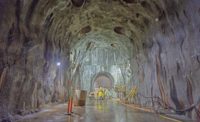The ability to make progress varied depending on stubborn geologic conditions and how fast crews could get materials down the access shaft. In open mode, more than 100 ft and as little as 20 ft were possible each day. In closed mode, a few inches were possible as well as distances of up to 70 ft. Due to the varied progress, timing became an additional challenge, according to team members.
"The TBM progress is based on the logistics with supplying that TBM with the footage we were getting that day," Nickerson says. "All of those materials, the segments, the grout, the rail, the piping extensions, all of that had to be lowered down a 600-ft shaft, then hauled by locomotive to the TBM."
Work halted for about two weeks in June 2012 after Thomas Albert Turner, 44, died in the tunnel during an afternoon swing shift. Investigators with the U.S. Occupational Safety and Health Administration found that the keystone of a ring segment slid forward 4 in. while the TBM was operating in closed mode, sending rocks and grout pressurized to 14 bar in Turner's way. No violations were issued, and project officials declined to comment.
Although the intake was originally planned to come online in 2012, the TBM broke through to the intake structure in early December. Before the project can come online—currently estimated to happen in July— several significant milestones will need to be reached. Sealing the connection between the intake tunnel and riser structure is under way now as well as disassembling the TBM and building a smattering of smaller utility pipelines within the tunnel.
While there are still several monumental tasks that need to be finished, Moonin says that thanks to pre-construction risk-management efforts, both the contractors and owner are not anticipating future issues.
"We had a very strong approach to risk-management. We had open communication meetings between the owner, the construction manager and the contractor, and we had experts, including our peer review committee," she says.
The contract also includes allowance accounts that provided the contractor leeway in dealing with "potentially variable items," Moonin explains, mainly pre-excavation grouting and hyperbaric interventions. Any funds that remained in those accounts will be split by the contractor and owner.
The provision "was designed to help [the joint venture firms] make their best estimate of the effort, but they were reassured that there was a pot of money that they could dip into if they exceeded it," Moonin says.
The deal provides an extra cushion. "If the contractor exceeds his line item for the lump sum, we go into this allowance item, and we also have a provision in there where they cannot claim for a different site condition until we use up that allowance item," she adds.
Moonin says that approach also allowed for quick decisions by the contractor. "It was under the contractor control as to what needed to be done. They were the design-builder as far as changing the plan," she says.





Post a comment to this article
Report Abusive Comment